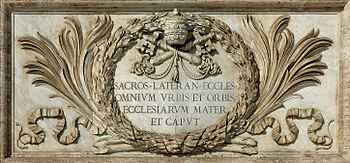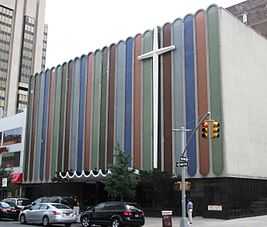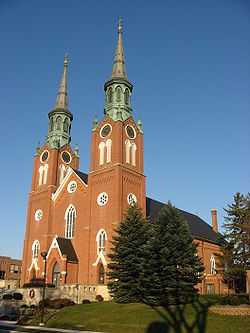Mother Church
In Christianity, especially the Roman Catholic Church, a mother church is the church "considered as a mother in its functions of nourishing and protecting the believer".[1]
A mother church also includes a parish church "which has responsibility for or oversight of another (as a chapel of ease, chantry, etc.)"; "The principal church of a country, region, or city; a cathedral or a metropolitan church"; "The original church of a particular Christian movement, serving as an organizational or spiritual centre; esp. the First Church of Christ, Scientist in Boston, Massachusetts, that of the Christian Scientists"; and "The church (i.e. organized body of Christians) of which another church or denomination is an offshoot; (also) the oldest or original church from which all others have sprung".[2]
"Church" as organization
Universal church
This term is most often used among Roman Catholics as the Holy Mother Church or Sancta Mater Ecclesia (Lat.). Another term often used in Catechism in many pious Catholic countries is the title "Mater et Magistra" (Mother and Teacher), referencing its matrimonial espousement to Jesus Christ. It is used as "Designating the whole Christian Church or all Christians collectively."[3]
Ecclesia matrix
Bingham in 1855 wrote: "Ecclesia matrix, a mother-church, is sometimes taken for an original church planted immediately by the Apostles, whence others were derived and propagated afterward. ... And in this sense the Church of Jerusalem is called 'the mother-church of all churches in the world.'" He also refers to "Arles the mother church of France, because supposed to be planted by the Apostle's missionary Trophimus, first bishop of the place." [4]
Roman Catholic Church
The Roman Catholic Church is thought by some to be the mother church of the Protestant and other churches that broke away from it over time. Prominent among these are Lutheran, Reformed, Anglican churches and other Christian faith communities formed over time from these.
Mother Church of the National Baptist Conventions
The National Baptist Convention, USA, Inc. is often referred to as the 'mother church' among African-American Baptists. This Convention is the oldest and largest of the Conventions and all other National Baptists trace origin to her. Not only do all National Baptists trace origination from the NBCUSA but several large Pentecostal Organizations do as well.


"Church" as building
First mission church
The first church built in a mission area is sometimes called the mother church. For example, the Cathedral of Our Lady of Peace in Honolulu, Hawai'i was the site of the first French Catholic mission of the Congregation of the Sacred Hearts of Jesus and Mary, from which the modern Hawai'i Catholic Church was established. Under these circumstances it is today considered the mother church of all Hawai'i.[5] Similarly, the Mission San Carlos Borromeo in Carmel, California is considered the mother church of California, as it historically served as the headquarters of the California mission system.
Cathedral
Mother church may also be a title of distinction based on a church's hierarchical importance. The church of the bishop of an episcopal see is often considered the mother church of the diocese. Holy Name Cathedral in Chicago, Illinois falls under this category. While it was not the first Roman Catholic cathedral of the city, it became the mother church due to the presence of the episcopal cathedra. This form of distinction based on hierarchical importance is usually used by the Roman Catholic Church, and, sometimes, the churches of the Anglican Communion,[6] while most Protestant denominations tend to refrain from using the title in this manner.
The Pope's cathedral, the Papal Archbasilica of Saint John Lateran, is called the mother church of all churches not only in the city of Rome but throughout the world.[7]
Principal church of a religious institute
The term may also relate to the churches of the various religious institutes, royal orders or civic orders. For example, Madonna Della Strada Chapel is the mother church of the Province of Chicago of the Society of Jesus. It is the principal church of the Jesuits in its particular province which includes Illinois, Indiana, Kentucky and Ohio.[8] On a broader scale, the Chiesa del Gesù in Rome is the mother church of all Jesuits throughout the world as it is the church of the order's Superior General.[7]
Plantation churches
Another form of the phrase is mainly used in Protestant churches. A mother church is a local church from which other local churches were planted. These churches are known as daughter churches. [9]
Historically significant churches
The oldest churches of various religious communities are often considered the mother churches to others that follow either in that same tradition or, alternatively, in a reformist tradition. A church's hierarchical importance is often derived from its historical importance in its organization. In addition, in communities where churches may change their ecclesiastical association or become independent (particularly in Pentecostal, charismatic and nondenominational churches in America), a mother church may have daughter churches in one or more organizations.
Mother Bethel A.M.E. Church in Philadelphia, Pennsylvania founded in 1794 is the "mother church" of the African Methodist Episcopal Church.
Mount Olive Holy Temple is the "mother church" of the Mount Sinai Holy Church of America. Bishop Ida B. Robinson began pastoring the church in 1919. In 1924, Mount Olive Holy Temple became the mother church of the denomination when it received its charter.
The mother church in Christian Science is The First Church of Christ, Scientist in Boston, the Church of Christ Scientist of which all others are branches. Per the Manual of The Mother Church, the legal title of the mother church is "The First Church of Christ, Scientist," and while its branch church may call themselves First Church of Christ, Scientist, or Second Church of Christ, Scientist, etc., they are prohibited from using "The" in front of their names. Only The Mother Church can do so.[10]
Greater Refuge Temple Church in New York City is the mother church of the Church of Our Lord Jesus Christ of the Apostolic Faith, an Apostolic Pentecostal denomination. As such, it is also ultimately the mother church of its various off-shoot churches and organizations, including both Bible Way organizations and the Church of the Lord Jesus Christ and its daughter churches. In addition, churches that were independently founded by ministers who were ordained or directly influenced by the church's founder, Robert C. Lawson, or his spiritual successor, William L. Bonner, may also look to Greater Refuge Temple as their mother church, including the Progressive Church of Our Lord Jesus Christ, the Evangelistic Church of Christ, and many others.[11]
References
Notes
- ↑ Oxford English Dictionary
- ↑ Oxford English Dictionary
- ↑ OED, under Universal.
- ↑ Bingham, J., The Antiquities of the Christian Church, University Press, 1855, p. 22-23.
- ↑ "Cathedral Art and Architecture". Retrieved 2012-04-11.
- ↑ See e.g. Rogers, KJN., A practical arrangement of ecclesiastical law,Saunders and Benning, 1840. p. 154.
- ↑ 7.0 7.1 Christian Rome Accessed 11 Apr 2012.
- ↑ Accessed 11 April 2012.
- ↑ Ordinary Pastor. http://www.ordinarypastor.com/?p=6406 Accessed 11 Apr 2012.
- ↑ Mary Baker Eddy Institute: The Manual of The Mother Church, by Mary Baker Eddy, Article XXIII, Titles. Section2, p. 25 online and p. 70 in book
- ↑ http://christtemple.tripod.com/chistory.html Accessed 11 Apr 2012.

